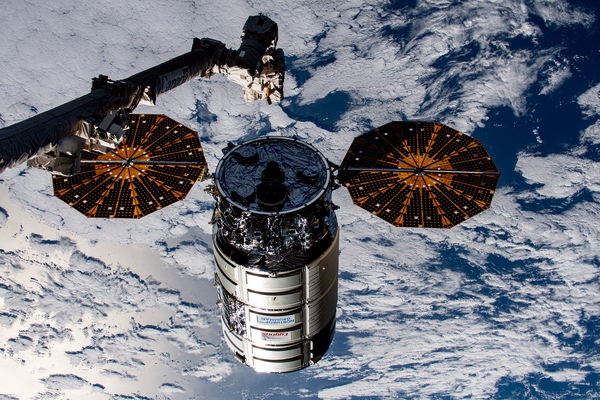Since I was a young child Mars held a special fascination for me. It was so close and yet so faraway. I have never doubted that it once had advanced life and still has remnants of that life now. I am a dedicated member of the Mars Society,Norcal Mars Society National Space Society, Planetary Society, And the SETI Institute. I am a supporter of Explore Mars, Inc. I'm a great admirer of Elon Musk and SpaceX. I have a strong feeling that Space X will send a human to Mars first.
Thursday, August 31, 2023
Wednesday, August 30, 2023
Monday, August 28, 2023
Saturday, August 26, 2023
Friday, August 25, 2023
Wednesday, August 23, 2023
1569 and 2023 Space Advocacy
1569 and 2023
by Bob Werb
Monday, August 21, 2023
The NewSpace community loves to use historical analogies and, as a charter member of that community, I’ve compared opening the space frontier to the European conquest and settlement of the Americas, Lewis and Clark’s travels, Roman road building, and probably others I don’t remember. Now, approaching my twilight years, I’m ready to admit that while these may well have been rhetorically useful, all are pretty weak analogies. There is, however, one historical analogy that I think is quite strong and compelling, as well as useful.
| Those among us who recognize the importance of space really do want to share our knowledge. Sadly, we are terrible at communicating that knowledge. |
So, please, close your eyes, climb into your TARDIS, and head to Europe in 1569, the year Mercator drew his famous map of the world. The general outlines of Earth’s landmasses were known as was basic information about trade winds and even some ocean currents. Even so, there remained a great deal left to discover. The technology of long-distance sea voyaging had advanced dramatically and wealth had been flooding into Europe, especially Spain, for several decades. The voyages of Columbus, Magellan, and Vasco da Gama, along with the conquest of the Aztec and Inca happened decades long past. While most educated people knew of the “New World” they had only the most basic information about its geography and ethnography—and much of that was wrong. Navigators kept their knowledge secret and, besides, Europeans had more immediate concerns. In England this was the Elizabethan age. Religious war ravaged France. The black death came back in waves every few years. The low countries were in revolt against Phillip II of Spain. With all this, few Europeans were paying attention to the geography and ethnography that was about to shape human history.
This is directly analogous to our current situation. The general outlines of our solar system are known as is basic information about available energy and material resources. Even so, there is a great deal left to discover. The technology of spaceflight has advanced dramatically, and wealth generated from space is rapidly becoming significant, especially for the United States. The voyages of Sputnik, Gagarin, Armstrong, and Aldrin happened decades long past. And, just like 1569, most Earthlings have more immediate concerns, some of which are genuinely existential.
One thing that is different this time is that those among us who recognize the importance of space really do want to share our knowledge. Sadly, we are terrible at communicating that knowledge. As a group we are mostly fascinated by math, science, and technology, so it’s only natural that we talk about opening the space frontier using the language of math, science, and technology. When we see that most people don’t get what we are talking about we bemoan their lack of something called “scientific literacy,” which some years ago Discover magazine described as “the knowledge and understanding of scientific concepts and processes required for personal decision making, participation in civic and cultural affairs, and economic productivity.” What a load of nonsense! Lots of people without “the knowledge and understanding of scientific concepts and processes” routinely engage in “personal decision making, participation in civic and cultural affairs, and economic productivity.”
Science teachers have long recognized the appeal of space (and dinosaurs) to young people and use them with great efficacy to stimulate interest among students—some of them, anyway. Even so, the reality of modern life is that the majority of people whom we think of as having a good education know very little about science and technology, and much of what they think they know is wrong. It’s not that they are ignorant. In fact, they may know lots of things few of us in the space community understand about subjects like the law, accounting, business, teaching, and politics.
| Every educated person would gain an improved understanding of the future by having a general idea about the useful resources available in space but has little need to know how we build spaceships. |
Here on Earth we have an area of study called geography that explores the relationship between our civilization and our physical environment, the results of which are widely accessible and extensively used by the non-technically inclined. Calling this the geography of the Solar System strikes me as awkward at best, so I made up the word Solargraphy.
Think back again to Europe in 1569. An educated person would certainly have known that a galleon was a type of ship but had no compelling need to understand exactly what made it special. It would have been useful to know a bit about the when and where of trade winds but hardly essential to know how to use an astrolabe. Knowing that large amounts of silver and gold was arriving from overseas was common knowledge; knowing generally where they came from was useful; knowing exactly how they were mined, not so much.
Again, the analogy holds up quite well. Every educated person would gain an improved understanding of the future by having a general idea about the useful resources available in space but has little need to know how we build spaceships. Concepts like delta-V and light seconds are very useful in understanding the relationships between different places, but it’s hardly essential to know how these things are calculated. Knowing that you will lose your GPS signal in a tunnel is common knowledge; knowing generally where the GPS signal comes from is useful; knowing exactly how it works, not so much.
I’m not in any way suggesting that we stop using space and dinosaurs to get young people interested in science. Having a larger part of our population gain even a basic understanding of science is clearly a valuable and worthy goal. I’m merely suggesting that we recognize that, for the foreseeable future, the majority of society’s decision-makers will be relatively inattentive to math, science, and engineering and that we can use solargraphy in much the same way we use geography to better inform all parts of society.
Bob Werb is one of the three co-founders of the Space Frontier Foundation and served for many years as its Treasurer and many more as its Chairman of the Board. He is also a mostly retired real estate developer of shopping centers, office buildings, and suburban garden apartments.
The Fault In Our Mars Settlement Plans
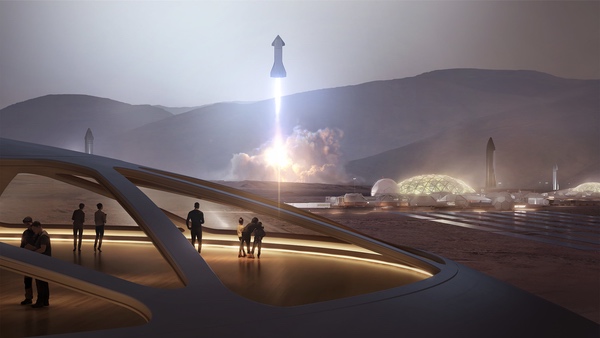 Popular visions of humans living on Mars often overlook serious technical and social challenges. (credit: SpaceX) |
The fault in our Mars settlement plans
by Isabella Cisneros
Monday, August 21, 2023
Think about the first human settlement on Mars. A constellation of images from science fiction, NASA, or SpaceX likely spring to mind: white cylindrical habitation units dotting a rusted desert landscape; an astronaut donning a futuristic skintight spacesuit to perform an EVA; inside, a botanist tending to a Martian greenhouse teeming with fruit and vegetables. But what aren’t we thinking of? Even with all our plans for Mars there are problems we’re stubbornly avoiding, like the dangers of radiation, the ethics and perils of reproduction in space, and handling of settlement resources. We imagine things working out because there are parts of the challenge we haven’t considered. We’re long overdue for a Red Planet reality check. In 1967, following the fatal Apollo 1 fire, NASA astronaut Frank Borman blamed the tragedy on “a failure of imagination.” NASA hadn’t fully considered the possible problems with their new spacecraft and paid a heavy price. Today, when it comes to Mars, our imaginations appear to be failing us again.
| Success on Mars will hinge on not only the technological aspects but also the social ones. Simply put, we are ignoring real factors that undercut these popular visions of humans on Mars. |
Readers of The Space Review are familiar with optimistic takes on Mars colonization and the state of the debate over how hard it might be. One example is John Strickland’s 2015 essay “Why humans should go to Mars and other places in space.” [1] In the piece, Strickland argues that travelling to Mars will actually be easier than ocean voyages of discovery were a few hundred years ago. Given the recent OceanGate tragedy, this is a statement we should be rethinking in more ways than one. He writes that the “isolation and stress of a Mars mission will be nothing like such maritime crews withstood.” Though Strickland is basing his claim on technological advancements, thinking of spacefaring as easier than seafaring simply doesn’t make sense. He also distorts history, writing, “[o]ne nice thing about future Mars colonization is that, unlike the Americas, there are no existing inhabitants to displace.” To be clear: inhabitants of the Americas were not displaced, they were victims of genocide. Whether it’s in the service of rewriting history or advocating for a specific future, bending the truth into self-serving narratives sets the stage for failure—not success.
Strickland’s piece is just one of many offering a picture of humans on Mars in which inconvenient details get bracketed off, downplayed, or ignored. Though logistics and feasibility should be front and center, so too should matters of human rights and ethical issues inherent in a Mars settlement. Success on Mars will hinge on not only the technological aspects but also the social ones. Simply put, we are ignoring real factors that undercut these popular visions of humans on Mars. Instead of ignoring these inconvenient truths, we must urgently foreground them in our discussions. If we are to remain on a relentless track towards human colonization that figures like Elon Musk envision for humanity, we need to address these concerns long before the first human steps onto the Martian surface. The rest of this article reviews just a few of the problems that mainstream conversations have been avoiding, focusing specifically on issues of human health and sociopolitical concerns.
Human life on Mars is untenable for several reasons. Its atmosphere is incredibly thin, measuring 0.08 psi. For comparison, Earth’s atmospheric pressure measures 14.7 psi. Additionally, its atmosphere is almost completely composed of carbon dioxide, meaning that we would be unable to breathe.[2] The Red Planet only has 38% of Earth’s gravitational pull, resulting in microgravity conditions that could pose threats to human health. Mars is also incredibly cold, with average temperatures hovering around –62 degrees Celsius. [2] To top it all off, Mars has a weakened magnetic field, meaning that humans would have little to no protection from radiation, which could in turn damage the DNA in our cells.
While thought to protect humans from the threats inherent to conditions on Mars, the conditions within the habitat modules our explorers would inhabit are dangerous in and of themselves; life on Mars will be characterized by isolation, monotony, and constant vigilance against ever-present danger. Even something as small as going for a walk outside will be arduous, with EVA suits having to protect against multiple life-threatening conditions waiting outside the door. Scientists and scholars have implied that survival in these conditions will require extreme sacrifices, whether that be everyday social and cultural norms or even fundamental human rights. In a piece concerning human rights on Mars, for example, Bloomberg Opinion columnist Tyler Cowen floats the possibility of what he calls “contractual servitude” as well as military and theocratic rule, displaying the variety of possibilities a presence on Mars could bring about—as well as the consequences.[3] Regardless, we need to ask ourselves if populating Mars is worth sacrificing hard-won human rights and consider how these changes may end up implemented back here on Earth.
| With concerns of human survival comes the question of who exactly decides how matters will unravel on Mars. |
Academics interested in fields of bioethics and space exploration have attempted to grapple with these challenges and propose solutions to them. A prime example of these attempts is exemplified in a study published in the journal Acta Astronautica in 2018.[4] Szocik and his associate authors use Maslow’s hierarchy of needs as a foundation for the concerns that must be addressed to successfully maintain a human settlement on Mars. Besides the already problematic use of Maslow’s hierarchy, which has been shown to lack supporting evidence and validity, the authors show a concerning callousness in their treatment of what are purportedly essential human needs.[5] Of particular concern is their discussion of psychological threats to human success on the planet, which include “lack of evacuation capability, significant communication delay with Earth, and the constantly diminishing view of mother Earth,” the last of which could lead to “an extremely pathological case of separation anxiety that could trigger an existential crisis and lead to suicide and even a desire to destroy the space vehicle and the rest of the crew.”[6]
These psychological threats are ones that are essentially unsolvable; while we can attempt to simulate our loved ones or incorporate biophilia into a hab environment, there is simply no means of bridging the millions of kilometers that lie between Mars and Earth. Consequently, the psychological effects of these threats are ones that we can, at best, mitigate and, at worst, doom astronauts to suffer. While the physical aspects of human health are the ones that immediately come to mind, when considering the difficulties of a human presence on Mars, the psychological aspects are just as, if not more, important to long-term habitation.
The difficulties of establishing a human settlement on the Red Planet don’t begin on the planet itself, either. Space Adaptation Syndrome (SAS) is a form of disorientation that occurs during space travel in which astronauts “suddenly feel as if they are upside-down or may even have difficulty sensing the location of their own arms and legs.”[7] As of now, there is no test that can predict whether an astronaut will experience SAS while in space. [7] If there are physical aspects of human health in space that we cannot ascertain on Earth, how are we to properly equip astronauts with the resources and training necessary to mitigate the psychological threats they will encounter, either in space or on Mars? What if there are psychological problems we are still unaware of? Can we, in good conscience, send astronauts on such a mission without knowing all the risks?
Let’s assume that, despite these problems, we are able to establish a human settlement on Mars. Sustaining a human presence will, inevitably, require humans to reproduce there. In another study published by Szocik in the journal Futures, he and his coauthors delve into what they term the biological and social challenges of human reproduction on Mars. They assume a minimal viable population (MVP) of around 5,000 individuals is required to sustain the settlement, especially in the face of unpredictable catastrophes.[8] While the authors consider new arrivals as a means of supplementing the population, they determine that in situ reproduction is ultimately the means through which the settlement must sustain itself. This is where another concerning problem begins. In discussing the possibility of a child being born with disabilities, the authors claim that “the birth of a disabled child would be highly detrimental to the colony” and that the use of settlement resources and effort to support this person “wouldn’t result in development of the colony and its community.”[8] Here, we begin to see glimpses of an insidious perspective: the prioritization of the colony over the human rights of those that comprise it.
The authors then consider two methods of solving this supposed conundrum: abortion or genetic engineering. The discussion of the first method is one marked by coldness, in which members of the community who become pregnant are expected to submit to an abortion if a fetus’s disability is predicted to tax the settlement’s resources. While Szocik’s vision is one in favor of abortion, it lacks a central component of it: choice. In this scenario, someone could be forced to abort a wanted child to safeguard the settlement’s resources or be forced to carry an unwanted child to term. The emotional and psychological effects of either situation are notably absent from this discussion. Likewise, the second method is discussed in a method clearly ignorant of the context underlying it, with the authors merely stating that “such technology and its ethical implications has yet to be fully developed.”[8]. If we were to start utilizing genome engineering to create “viable” progeny, who knows where we will stop? While the authors clarify that this technology wouldn’t be used for the purpose of eugenics, who are they to declare what can or cannot be done with this technology on a planet whose policies and inhabitants are operating within completely different parameters of survival? Additionally, the technology that is developed on or for Mars will likely be used back on Earth too; once we start descending this slippery slope, will we be able to stop?
With concerns of human survival comes the question of who exactly decides how matters will unravel on Mars. According to the Outer Space Treaty of 1967, which was drafted by the United Nations, space is designated as “the province of all mankind” and no sovereign nation can claim the Moon or other celestial bodies.[9] For a country to claim a piece of Mars seems unlikely, but what about a private company? In an interview regarding this question, Elon Musk, CEO of SpaceX, advocated for a direct democracy, which he felt would remove the possibility of corruption.[10] However, if astronauts arrive under a company banner, who is to say that this governmental structure will hold? The establishment of a human settlement on Mars will be an exorbitant financial measure, one that no company or sovereign nation will undertake without some kind of insurance as to its success. After all, why would a company attempt to establish a settlement if not to create a lucrative enterprise out of it?
Consequently, this aspect of control over the settlement could play out in multiple ways. For example, to fend off the deleterious effects of reduced gravity on human health, a human living on Mars would have to exercise an extensive amount every day to stay in relatively perfect health.[4] What would be the consequence of noncompliance on this point? Will one’s vitals and health be consistently monitored to ensure this compliance? Will they be punished if they don’t comply? This aspect of control is one implicit in subjects of reproduction, especially as they have been discussed in this article. However, it is one that must be extended to the most fundamental features of human existence. To go to Mars and establish a settlement is to relinquish some aspect of control over our lives. While the awe of space exploration and sentiments of human accomplishment provide a bold vision to the idea of human settlement of Mars, there is a very real undercurrent of capitalist exploitation underlying it. Why else would we attempt to live and work on a planet that is fundamentally incapable of maintaining human life?
| Put simply, plans about Mars are always plans about Earth. That colonization and politics are present in these sentiments is a warning we must abide. |
While the Red Planet may represent a kind of futuristic human experiment or possible utopia to some, we must be wary of the fact that the problems we face on Earth won’t disappear once we get to Mars. Travelling to Mars does not inherently mean transcending our problems back on Earth. Ask yourself, truly, what is the point of colonizing Mars? While sending temporary crewed missions to Mars could allow us to return samples for scientific analysis or accomplish certain tasks that the rovers currently on the planet cannot, why live on Mars long-term? Why attempt to establish a human presence on a planet that fundamentally cannot support the survival and propagation of human life? When figures like Robert Zubrin or Elon Musk advocate for the colonization of Mars, what are they really advocating for?
In an interview, Zubrin compares human colonization of Mars to actual historical colonization efforts, claiming that only through the colonization of another world or another planet can we foster new technology and civilization.[11] Zubrin goes on to say that we must terraform Mars and build an “additional Earth.”[11] Similarly, critics of Musk have suggested that his desire to populate Mars lies not in a vision of human unity and expansion across the stars, but one originating in frustration with politics in the United States.[10] To assess the success of a Musk-run planet, one need not look farther than his recent takeover of Twitter, which has been characterized by lawsuits, plummets in profit, and temper tantrums.[12, 13] If Musk cannot so much as handle criticism of himself on a social media platform, can we really expect him to create a form of governance based on principles of democracy and freedom?
Put simply, plans about Mars are always plans about Earth. That colonization and politics are present in these sentiments is a warning we must abide. It is not until we confront the truth that underlies these discussions, and the real consequences of Mars colonization for the human beings we send there, that we can fully understand just what is at stake both in these conversations and their products. While establishing a settlement on Mars may be in our future, until we confront the reality of what it will take to accomplish such a feat, we are nowhere close to ready to realize this goal. In truth, given what we are willing to sacrifice to make it to the Red Planet, we are further from being able to achieve this goal than we have been led to believe.
References
- Strickland, John. “Why humans should go to Mars and other places in space.” The Space Review. January 19, 2015.
- Dobrijevic, Daisy. “Mars’ atmosphere: Facts about composition and climate.” Space.com. February 25, 2022.
- Cowen, Tyler. “Human Rights on Mars Won’t Be the Same as Those on Earth.” Bloomberg. June 28, 2022.
- Szocik, Konrad, et al. “Psychological and Biological Challenges of the Mars Mission Viewed through the Construct of the Evolution of Fundamental Human Needs.” Acta Astronautica, vol. 152, Nov. 2018, pp. 793–99. ScienceDirect.
- Fallatah, R.H.M., Syed, J. (2018). A Critical Review of Maslow’s Hierarchy of Needs. In: Employee Motivation in Saudi Arabia. Palgrave Macmillan, Cham. https://doi.org/10.1007/978-3-319-67741-5_2
- Souvestre PA, Landrock CK, Blaber AP. Reducing incapacitating symptoms during space flight: is postural deficiency syndrome an applicable model? Hippokratia. 2008 Aug;12 Suppl 1(Suppl 1):41-8. PMID: 19048092; PMCID: PMC2577399.
- “Mixed Up in Space.” NASA Science Mission Directorate. Accessed 30 Nov. 2022.
- Szocik, Konrad, et al. “Biological and Social Challenges of Human Reproduction in a Long-Term Mars Base.” Futures, vol. 100, June 2018, pp. 56–62. ScienceDirect.
- Treaty on Principles Governing the Activities of States in the Exploration and Use of Outer Space, including the Moon and Other Celestial Bodies (Outer Space Treaty), Jan. 27, 196718 UST 2410; 610 UNTS 205; 6 ILM 386 (1967)
- Grush, Loren. “Elon Musk thinks the best government for Mars is a direct democracy.” The Verge. June 2, 2016.
- Chow, Denise. “Robert Zubrin wants to establish ‘a new branch of human civilization’ on Mars.” Mach. August 19, 2018.
- Wagner et al., “Elon Musk’s Twitter Is a Shakespearean Psychodrama Set in Silicon Valley.” Bloomberg. December 14, 2022.
- Maurer, Mark. “How Elon Musks’s Twitter Faces Mountain of Debt, Falling Revenue and Surging Costs.” Wall Street Journal. November 21, 2022.
Isabella Cisneros is a recent graduate of The University of Chicago interested in astrobiology and current space exploration efforts. While at the university, she was a research assistant with SPACELAB, a research unit interested in understanding public perceptions of the search for life in our universe. All views and opinions expressed are her own.
Russia Is Not A Declining Space Power (?)
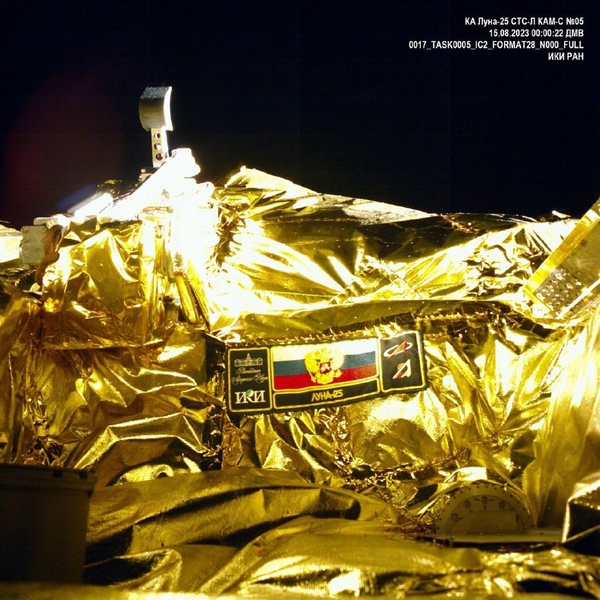 An image returned from the Luna-25 spacecraft days before a malfunction caused it to crash on the Moon. (credit: Roscosmos) |
Despite the Luna-25 failure, Russia is not a declining space power
by Daniel Duchaine
Monday, August 21, 2023
In the aftermath of the Luna-25 failure, a cacophony of voices from major news outlets and space pundits have been quick to paint Russia as a great power in decline. This viewpoint, while emotionally satisfying given Russia’s abhorrent actions in Ukraine, is not based in reality. But it is vital, both for understanding and for strategy, that we refrain from making sweeping conclusions based on isolated events. In the last decade, Russia has rebuilt and reinvested in its military space capabilities and has stabilized its share of space power.
| In the last decade, Russia has rebuilt and reinvested in its military space capabilities and has stabilized its share of space power. |
Major news outlets suggest that Russia has been in decline in space since the fall of the Soviet Union. The New York Post stated of Luna-25: “Its failure highlighted the intense decline of Russia’s authority over space since the days of the Cold War, when Moscow was the first to launch a satellite — Sputnik 1 — to orbit the Earth.” Reuters and the New York Times echoed with similar sentiments. Reuters stated: “The failure underscored the decline of Russia's space power since the glory days of Cold War competition when Moscow was the first to launch a satellite to orbit the Earth — Sputnik 1, in 1957 — and Soviet cosmonaut Yuri Gagarin became the first man to travel into space in 1961.”
With the common wisdom seeming to be that Russia is a great power in decline in space, let us consider a more systematic understanding of Russia’s space power.
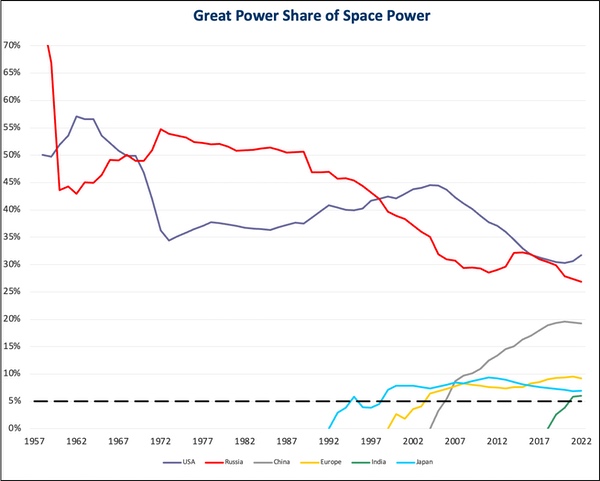 |
The Space Power Index
The Space Power Index is an index I created to try to quantitatively measure how much power a state holds in the space domain, relative to the system as a whole (see “Is China’s rise in space over? Indexing space power for the next space age”, The Space Review, July 31, 2023.) It is based on cumulative objects launched into orbit, scientific achievements, and space military capabilities. While I considered every state with a space program, only those that cracked 5% of total space power at some point in their history are considered great powers and are included in the system.
Cumulative Orbital Launches: I chose cumulative orbital launches as an input for a number of reasons. First, it shows that a state has the technological capacity to design, build, and deploy space technology. Second, it shows that the state has a high industrial capability, required for launching large numbers of satellites. Third, it is a reliable and easy to find datasets that are consistent for all states.
Scientific Achievements: This input is a binary for a variety of space scientific achievements. When a state accomplished one of these achievements, it gained 1 unit of the input. Scientific achievements show that the state is able to overcome significant scientific and technological challenges.
Military Capabilities: Similar to Scientific Achievement, this index is based on whether a state is thought to have certain military capabilities in space like direct ascent ASAT or electronic warfare capabilities.
This index may seem subjective, and it is. Great power status is inherently subjective. It depends on whether the other international systems consider your country as a great power. India probably wasn’t objectively a more powerful country the day before it launched a direct ascent anti-satellite (ASAT) weapon, but doing so got the attention of the rest of the system. So, the goal for this index is to track things that would make a country seem powerful. You can check my data as a Microsoft Excel sheet here.
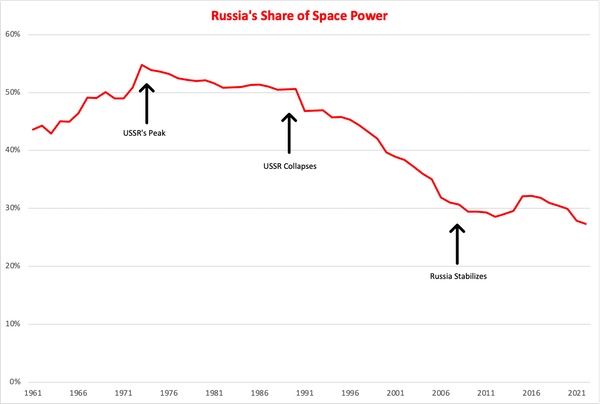 |
History of Russian space power
Dominance: From the beginning of the space age until the 1990s, Russia, as part of the USSR, dominated the space system. From launching the Salyut 1 to introducing the first Mars probe, the USSR was an unrivaled force in space, demonstrating not just scientific, but also formidable military capabilities.
With the launch of the first space station: Salyut 1, the First Mars impactor, the First Mars probe, and the development of counter space capabilities in the form of Almaz, 1971 was the peak of the Soviet share of Space Power (not including the years when the USSR was the only space power). In the 1970s and ’80s, the US caught up in scientific achievements, but the USSR continued to lead in objects launched, military capabilities, and maintain its place as the dominant space power.
| Momentary failures should not dictate our understanding of a nation’s overall capabilities. We should not underestimate Russia’s capabilities. |
Decline: From 1990 to 2012, Russia actually was a space power in decline. Key space infrastructure, primarily developed during the Cold War for missile warning and defense, began to crumble. Financial constraints crippled Russia's space endeavors, leading to fewer payloads being launched and a pause in achieving new scientific milestones. The biggest factor, however, was the decline in Russia military capabilities, namely its space situational awareness (SSA) capabilities. From the Secure World Foundation’s Global Counterspace Capabilities Report: “Russian SSA capabilities date to the Cold War and leverage significant infrastructure originally developed for missile warning and missile defense. Although some of these capabilities atrophied after the fall of the Soviet Union.” In the mid-1990s, the US surpassed Russia as the dominant space power, and the entrances of Europe, China, and Japan into the system further ate into Russia’s share of space power.
2010–2022: Contrary to prevailing opinions, the past decade has been a period of stabilization for Russia. Its share of space power was on the rise in the mid-2010s, though fittingly, this was slowed by India’s entrance into the system. Russia’s share of space power in 2022, 26.7%, is basically the same as it was in 2007, 26.8%.
This past decade Russia has steadily increased its share of objects launched, maintained its share of scientific achievements, but most importantly has reestablished its lead as the preeminent military space power. This is due to Russia’s revitalization of its Soviet-era military space systems led by the new Russian Aerospace Forces, created in 2015. Russia restarted rendezvous and proximity operations (RPO) testing in both low Earth orbit and geosynchronous orbit, signaling a potential co-orbital ASAT program in the works. Russia’s Luch satellite maneuvered and lingered near an Intelsat satellite for about 145 days, playing a “cat and mouse game.” Additionally, Russia has also tested an ASAT weapon nearly every year from 2014 to 2021. This includes direct-ascent ASAT weapons like the notorious 2019 and 2021 debris-generating tests. Since the war in Ukraine began in 2022, Russia demonstrated cyber capabilities, hacking a Viasat ground station and jamming capabilities throughout Eastern Europe.
In the light of the Space Power Index, a different picture of Russian space power emerges. While Russia’s scientific space sector has plateaued, Russia’s share of launches increased gradually and Russia’s share of military capabilities increased this decade.
Momentary failures should not dictate our understanding of a nation’s overall capabilities. We should not underestimate Russia’s capabilities. Luna-25’s demise is not emblematic of Russia's space trajectory, and it should not distract from the reality that Russia is rebuilding its military space systems, stabilizing its space power, and remains a capable and potentially dangerous space power with a highly capable space military.
Daniel Duchaine is a Fellow at the Center for Space Governance.
Note: we are using a new commenting system, which may require you to create a new account.
Monday, August 21, 2023
An Alien Species Found In Antarctica?
DISCOVERIES
Stars in the Ice
Scientists studying Antarctica’s waters found a new alien-looking species which they named after a popular fruit, Insider reported.
Meet the Antarctic strawberry feather star, a sea creature measuring up to eight inches long and sporting 20 so-called “arms.”
In their study, researchers explained that the creature – formally known as Promachocrinus fragariu – has a “strawberry-like” central body and its natural color can range from “purplish” to “dark reddish,” according to Gizmodo.
They said the species’ arms are of varying textures, with some being bumpy and others feathery. These appendages are typically spread out and upward, aiding their movement.
The P. fragariu belongs to the Crinoidea, a class of species that includes starfish and sea urchins.
Found between around 200 and 3,800 feet below the ocean surface, its discovery is particularly important because scientists initially believed there was only one species under the Antarctic feather star group – the P. kerguelensis.
Following genetic and body analyses, the authors confirmed that they found seven other species of Promachocrinus, including four species previously never named by scientists.
“So we went from one species with 20 arms to now eight species – six with 20 arms and two with 10 arms under the name Promachocrinus,” co-author Greg Rouse told Insider.
There could be more unknown creatures lurking under the frozen continent’s sea, the authors said.
Still, that strawberry-like marine animal resembles the alien creature from “The Thing” movie – which is also set in Antarctica.
Sunday, August 20, 2023
Friday, August 18, 2023
Thursday, August 17, 2023
Wednesday, August 16, 2023
Tuesday, August 15, 2023
Saturday, August 12, 2023
Friday, August 11, 2023
Thursday, August 10, 2023
Tuesday, August 8, 2023
Effects Of Upgrades To Starlink Generation 2 Satellites On Visual Brightness
Effect of upgrades to Starlink Generation 2 satellites on visual brightness
by Brad Young and Jay Respler
Monday, August 7, 2023
The rise of large constellations of small communication satellites in low Earth orbit (LEO) over the last four years has, with it, led to concerns about the effect on space situational awareness, ground-based visual and radio astronomy, and the effect on the health and well-being of the natural world, including humans. Several studies have published the measurable effects of these concerns, and several more studies are ongoing. The issue has brought efforts, including new laws, to retool the licensing process for LEO in a new era of hundreds of thousands of small satellites instead of hundreds of large objects.
| Understanding the effects on all stakeholders requires two steps: measuring the evolving threats and monitoring the engineering mitigation for effectiveness. |
Specifically, the authors have concentrated their efforts on observing, reporting, and publishing data on the prototype Blue Walker 3 from AST Space Mobile and the still-growing OneWeb and Starlink constellations. The aim of this article is to present new observations of the initial Gen 2 Starlink satellites and discuss how their brightness is likely to contribute to the ongoing impact on optical astronomical observations.
On February 27, 2023, the first of the Gen 2 Starlink satellites was launched into orbit. This initial slate of 22 satellites were not the “final” version of the Gen 2 design, but a modified Gen 1 payload that was an interim step in design, referred to as Gen 1.5. Visual observations conducted after the group reached operational orbit suggested that these satellites would be particularly bright, as expected with a larger object compared to the Gen 1 design. They also had a blue color not seen previously, due to a new material selected by SpaceX specifically for reduction of optical brightness.
Background
Operators of these megaconstellations have begun to launch their satellites, ranging from prototypes to second generation designs. Understanding the effects on all stakeholders requires two steps: measuring the evolving threats and monitoring the engineering mitigation for effectiveness. SpaceX has the largest number of satellites in orbit currently and is the earliest major entrant. Early reports on the deleterious effects of their satellites on astronomy led to engineering changes in orbital parameters and design to reduce their reflectivity. With Gen 1—the original, smaller Starlink satellites—changes included orbital height adjustment, a visor (VisorSat), and special coating (DarkSat). This study looks at the reduction in optical brightness reached in the upgrade to Gen 2, where significant design changes were made to accommodate a larger object. A summary of the changes incorporated by SpaceX may be found here.
SpaceX is aware of the significant effect of solar phase angle on these long, flat satellites and instituted a policy of operating in a “shark fin” attitude that minimizes reflection of sunlight to Earth. However, this angle changes often throughout the orbit and must also adapt to any orbital changes. Many of the observed satellites that were suddenly bright on one pass were occasionally dim on a later pass with similar geometry, indicating the small room for error that this “knife’s edge” mode allows.
Methods
All the data used for this analysis is visual magnitude, determined by using the methods below. The observations were performed by:
- Jay Respler, a dedicated satellite observer who has logged hundreds of brightness reports on Starlinks and OneWeb payloads since the first launches.
- Brad Young, who has reported on 90% of the Starlinks in orbit and has seen more than 9,000 unique objects in orbit visually, resulting in over 40,000 reports.
Visual observations were undertaken from March 16 to July 25 of 2023 from sites near Tulsa, Oklahoma, and Monroe, New Jersey. In most cases, hand-held binoculars were used to perform visual observations, using the following procedure. First, pass predictions are obtained for the observer's site. At a minimum, the location, expected time of observation, and the limiting magnitude an experienced observer can reliably see must be known, bearing in mind that moving objects may appear dimmer visually. Observable passes at low elevation, in deep twilight, or at unfavorable phase angles are discarded.
Next, suitable comparison stars are chosen to provide brightness measurements. The timing, location, and brightness of newly launched satellites often differ significantly from available pass predictions. Sufficiently bright comparison stars to enable magnitude estimation are selected for the appropriate stage of twilight, and alternate stars chosen in case the satellite pass was off track or early/late. All comparison star magnitudes are from the extended Hipparcos catalog.
Finally, the objects are observed as they pass the selected comparison stars, so a direct comparison can be made and immediately recorded. Any significant brightness variation (flashing or flaring) was also recorded at that time. Although brightness variations are not used for determining standard magnitudes, they may still provide useful space situational awareness information.
Discussion
Initially, as with Gen 1 launches, the objects were quite bright, easily seen with the naked eye and as bright as magnitude +1. After a period of a few weeks and with more observations, many of the objects from the first launch were found to be dim. Eventually, many of the Gen 1.5 and especially the Gen 2 satellites were dimmed to the point where they could not be seen by a visual observer using binoculars.
However, continued observation showed that the dimness was not always permanent. Occasionally a payload would become naked-eye brightness again, and then return to dimness, or remain bright. Refer to Figures 1–4, which describe the observed corrected magnitude of the Starlinks Gen 1.5 and Gen 2.
| Despite many efforts by the aerospace industry, policymakers, astronomers, and the community at large, the trend to make substantially larger and brighter satellites seems to persist. |
The corrected magnitude is the apparent magnitude of the satellite, correcting the distance to 1,000 kilometers. Due to the complexity of modeling the shape of the Starlinks and unknown albedo and scattering behavior, a simpler model provides a way to compare differential brightness. No attempt is made to determine standard magnitude using phase angle; only range is considered. Therefore, this paper does not determine a standard magnitude for any of these satellites. Comparison to the target maximum brightness set by the International Astronomical Union (IAU) of magnitude 7.2 is based on the range corrected magnitude in this study. The light curve of the payloads in shark-fin mode are nearly flat across most of the pass through the sky, so this approximation should be acceptable for the purpose here.
With this approach, some trends in the behavior of the new generation satellites are shown. Whatever transitory changes were made with Gen 1.5, many of that set did not perform as well as the “true” Gen 2 payloads. Two graphs show the typical outcomes so far for Gen 1.5. Note that not all the observed satellites are included in the data, only enough to show the trends but remain readable. Also, a few of the ranges are estimates due to the short life of elements with initial orbital raising and the inherent lag in dissemination of elements for these objects.
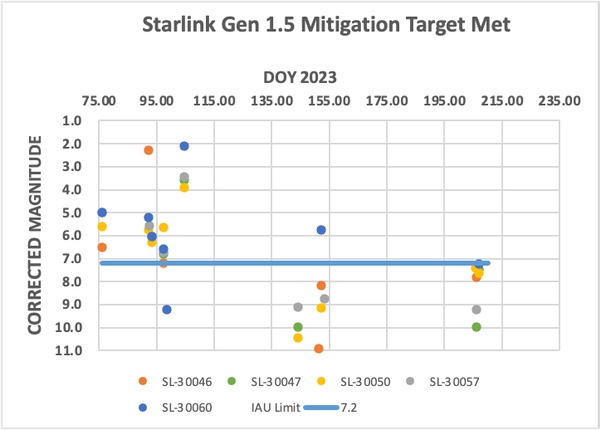 Figure 1 |
Gen 1.5 has several payloads that, as of July 30, 2023, have not met the criteria of a range-corrected magnitude of 7.2. The graph above shows examples of payloads successfully mitigated to the recommended parameter. The next graph shows examples of objects that, so far, have remained brighter than desired.
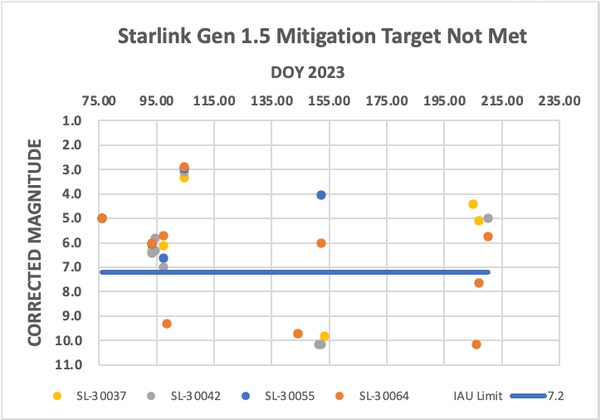 Figure 2 |
Gen 2 satellites have been more consistent in making the mag 7.2 mark; examples of these are shown in the third graph, and the last graph shows examples of the Gen 2 that did not meet it. The behavior of the satellites may indicate that the orbit modifications and positioning for Gen 1.5 were more elaborate than those needed to line out Gen 2. This may be indicative of an operator learning curve to maximize brightness reduction, or there may be reasons for this behavior that have little to do with brightness mitigation. It is an active situation: there are still many new Gen 2 groups that have had only a few observations. Those payloads are in the early stages of reaching final orbit and were not included here.
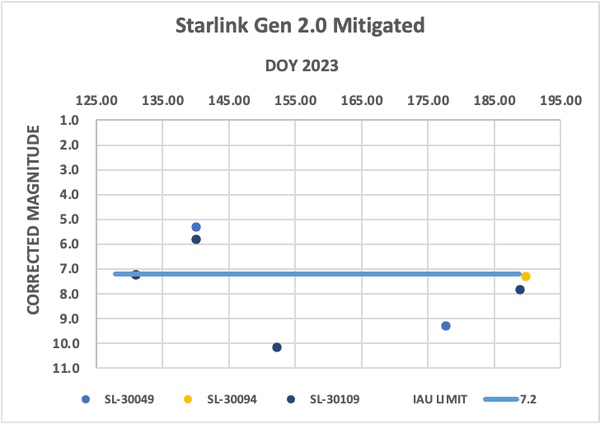 Figure 3 |
Further study is needed to determine what patterns emerge and what explanations may predict behavior. Monitoring by the astronomy community would be most efficiently accomplished by crowdsourcing the effort to amateurs. Although SpaceX has made great progress in reducing the brightness of a new, larger Starlink, we see already, through hundreds of observations, that there are still bright Gen 2 objects at final orbital height.
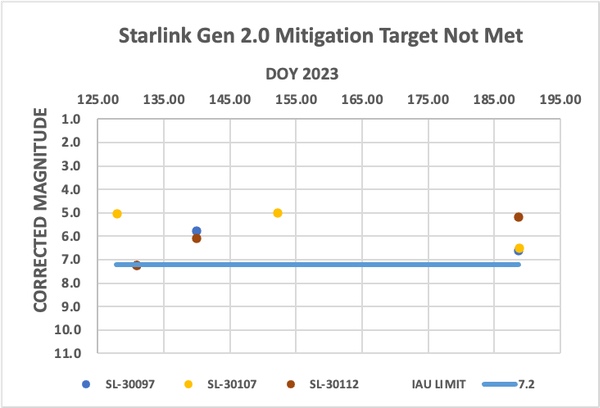 Figure 4 |
Path forward
The IAU recommendation is that the maintained brightness on-station of a satellite is not to exceed magnitude 7.2. Satellites such as Starlink Gen 2 could also present an additional source of noise for radio astronomy since radio quiet zones, in which radio telescopes operate, do not automatically limit satellite emissions. This can be a particular issue for telescopes like the NRO at Green Bank which observe at or close to frequencies normally used by devices served by satellites. The planned constellation of thousands of such satellites over the next decade may necessitate more research into effective strategies to protect upcoming ground-based telescopes and surveys such as the Extremely Large Telescope (ELT) or the Vera C. Rubin Observatory's Legacy Survey of Space and Time (LSST).
Despite many efforts by the aerospace industry, policymakers, astronomers, and the community at large, the trend to make substantially larger and brighter satellites seems to persist. Regulatory intervention could help ensure operators critically assess the impact of their satellites on the space environment before launch.
Communication with SpaceX confirmed that mitigation had included both design modifications to the satellites (the final Gen 2 set), and changes in attitude and other spatial adjustments after orbit was achieved. In a few cases, signal to the satellite had been lost, and this caused a delay in the mitigation, explaining the behavior seen from the ground. However, not all the behavior is explained by this alone; it may be a case where vigilance is required by the operator in maintaining the spacecraft attitude or other parameters.
A proactive industry-led solution is investment in engineering solutions that allow payloads as large as the Gen 2 Starlinks to be operated without causing unmanageable issues with optical and radio astronomy. From the observations on the Starlink Gen 2 satellites, it appears that SpaceX has found ways to meet the IAU recommendations on optical brightness. Further study, as more of this portion of the constellation is launched, will help ensure the concerns of all stakeholders are met.
Acknowledgements
Brad Young [ORCID 0000-0001-6268-7790] is an affiliated member of the IAU Centre on the Protection of the Dark and Quiet Sky from Satellite Constellation Interference and would like to acknowledge their invaluable assistance in understanding the more technical aspects of the mitigation strategies employed by SpaceX.
References
“Megaconstellation Satellites: Practical Ways Amateurs Can Help” Reflector, March 2022, p. 25
Dark and Quiet Skies Working Groups Reports II UN Office for Outer Space Affairs, edited by Connie Walker and Piero Benvenuti
Reclaiming Space: Progressive and Multicultural Visions of Space Exploration, edited by James S.J. Schwartz, Linda Billings, and Erika Nesvold
“Second Generation Starlinks Satellites” monograph by SpaceX
“Hubble Telescope Faces Threat From SpaceX and Other Companies’ Satellites” New York Times, Mar 2, 2023, accessed Aug 1, 2023
Observational data posted at see-sat mailing list archives and Brad Young’s website.
Brad Young, PE, is Lead Coordinator - Visual Observing for the International Astronomical Union Centre for the Protection of the Dark and Quiet Sky from Satellite Constellation Interference; Astronomer of the Year (2023) Mid States Region of Astronomical League; and Platinum Level Observer.
Jay Respler has been observing satellites since the Sputnik 3 rocket in 1958. He is responsible for adding RCS to the Satellite Situation Report and is moderator of VISUAL.TLE at Celestrak for 25 years.
Note: we are using a new commenting system, which may require you to create a new account.
The Show: Meanwhile On Mars
Meanwhile, on Mars…
by Dwayne A. Day
Monday, August 7, 2023
We’re in the waning days of the long, hot summer of 2023. The Hollywood writers and actors are on strike, movie debuts are being delayed and, while some new shows are still debuting on streaming services, there will not be much of a fall television season other than game shows and maybe some new cartoons. But “Stars on Mars” is still chugging along.
| “Stars on Mars” is less of a reality TV competition and more of a low-key episodic science fiction show. |
When we last left our seven remaining intrepid celebrities on the Red Planet, they had just been joined by a new batch of celebronauts consisting of a reality TV star, a celebrity chef, a basketball player, and a comedian (Conan O’Brien’s former sidekick, Andy Richter). Of the four, the only one who the first group seemed excited about was the chef, who could finally cook something other than the bland prepackaged food they had been consuming for over a week. They also got a treat in the form of a supply of hot wings and pizza, indicating that their mission planning was not being done by a nutritionist (see “Reality is underrated: Fox’s Stars on Mars takes off,” The Space Review, July 10, 2023.)
But the show had to go on, and soon the newly arrived reality show star had been deemed “not mission critical” and was sent home. The following week, one of the original crew, wrestler Ronda Rousey, became the third person to voluntarily take herself out of the competition. She missed her 18-mont-old child, and she no longer wanted to be there. Last week, Andy Richter was sent home, proving that Mars ain’t the kind of place to raise a comedian.
The original batch of celebrities were not exactly riveting personalities, and the new group is less so. But given its high production values, original premise, and ability to not take itself too seriously, “Stars on Mars” remains watchable, allowing for the lower standards we generally have for summer television. The alleged minor spats between some of the crew are like watching office gossip play out in high-def. Your coworker who always pops popcorn in the office microwave may annoy the heck out of many of you, but that is not the kind of offense that makes for a great story at the bar after work. Similarly, learning that disgraced cyclist Lance Armstrong likes to comment on a young woman’s appearance to annoy her and eats raw bacon out of a container doesn’t make him a particularly engaging supervillain. He’s just a bit of a jerk, and he seems to be okay with that, even if his pre-teen son may be watching him at home and learning all the wrong things to do to get along with people.
“Stars on Mars” is less of a reality TV competition (there’s no monetary prize for being named “The Greatest Star in the Galaxy”), and more of a low-key episodic science fiction show. To date the crises the celebrities faced have included: a wind-damaged communications tower, a ruptured water system, a fire in the greenhouse, alien mold that threatened their food supply, radioactive materials from a crashed spaceship, a meteorite strike on the hab, a crazy computer, and solar flares. These crises may not exactly be scientific, but they are at least sciency—within the realm of plausibility. The show has given its participants new and interesting things to do, and demonstrated that some attributes like physical strength and optimism may not be as important as others, like leadership and determination. Next episode, the crew faces a suspected alien monster in the air ducts. Hopefully they have flamethrowers.
Filmed in a forbidding part of Australia that has served as a good visual backdrop for prior movies and TV shows, the crewmembers do appear to be struggling with many of the challenges, primarily due to having to wear heavy simulated spacesuits while navigating minor obstacles that would otherwise be simple without the suit. None of the challenges so far has really forced them to be clever at problem-solving, although they have had to be resilient.
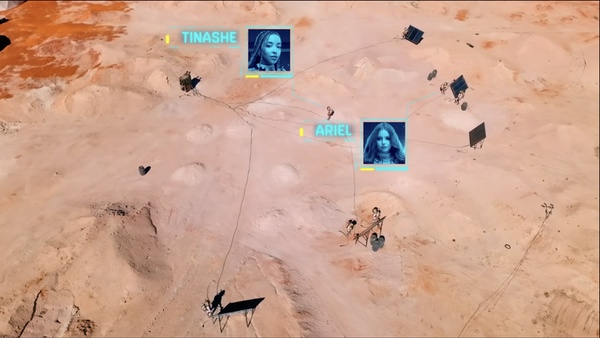 The production design and filming for the reality show are top-notch. The show was filmed recently in a remote part of Australia that has served as the location for at least one movie set on Mars. (credit: Fox) |
Drama vs. melodrama on a red planet
Over the past decade there have been a few Mars-themed television shows, most of which undoubtedly owe their existence to the successful 2015 movie The Martian. In November 2016, The National Geographic Channel premiered a show called “Mars”, which included well-researched documentary segments interspersed between dramatic, but dull, scenes of a mission to Mars in the early 2030s. Season two aired in late 2018, and the show was canceled. In 2018, Hulu debuted its series “The First”, produced by and starring Sean Penn, about an astronaut going to Mars, but it never made it past one season. In 2020, Netflix premiered “Away”, about a trouble-plagued mission to Mars that lands during the last episode; a second season that would have taken place on Mars was canceled. Apple TV+ started its alternative history show “For All Mankind” in 2019. The first two seasons, involving lunar settings, were excellent, and the less interesting third season, which became available in 2022, was set on Mars. Although the fourth season started filming early this year, there has been no information about when it may debut and, unless they were completely done with live action filming, it could be on long-term hiatus like much of Hollywood. During that same period, an announced effort to turn Kim Stanley Robinson’s Red Mars/Blue Mars/Green Mars trilogy into a series evaporated. We’re still awaiting a great, or at least pretty good, television drama set on Mars.
| “Stars on Mars” may not have the best or most engaging celebrities, and it may be a little too constrained by its reality-show origins, but what it does have is a hint of The Martian’s heart. |
Real astronauts used to be heroes, but that has faded over time, along with their reputation in movies and television. One of the persistent problems with many of those earlier Mars-based shows is that the drama often stemmed from the Marsnauts being bad at their jobs, hindered by depression, showing a lack of commitment or purpose or focus, or occasionally having deep personal flaws. They often reflected a rather common and lazy trope in current television where characters are given tragic backstories, trauma as a shortcut to making them appear “deep.” Education, training, intelligence, hard work, and competence have rarely been portrayed as interesting character attributes in these shows.
These characters stood in contrast with Matt Damon’s astronaut Mark Watney in The Martian: when faced with adversity, Watney doesn’t mope but instead works hard to solve the problem. In one of his camera monologues he states, “So I got to figure out a way to grow three years’ worth of food here. On a planet where nothing grows. Luckily I’m a botanist. Mars will come to fear my botany powers.” It’s not bravado, it’s confidence imbued by training. Later on, after facing yet another setback, he declares: “In the face of overwhelming odds, I’m faced with only one option: I’m going to science the -hit out of this.” What makes the audience root for him, besides Matt Damon’s natural charm, is the fact that he is determined to never give up. That attitude has often been lacking in television dramas set on Mars, where the harsh environment is treated as secondary—or at least equal to—the inner demons plaguing the characters. Yes, the writers know that the characters still have to start the reactor and free Mars, but first they make them overcome their trauma.
Perhaps this says something about modern American culture, where it is so hard to define what makes a person heroic or admirable. Or maybe it has more to do with how Hollywood writes dramas today, and how much the language of pop psychology has seeped into how we define our world. Until its third season, “For All Mankind” largely avoided that problem and managed to depict characters who could be both flawed and admirable at the same time, like acerbic chief astronaut Molly Cobb, who falsely described herself as a “selfish prick,” but risked her life multiple times to save others, and paid a price for it. Hopefully, when the Hollywood strikes end, we’ll get to see more characters like her on Mars.
“Stars on Mars” may not have the best or most engaging celebrities, and it may be a little too constrained by its reality-show origins, but what it does have is a hint of The Martian’s heart, that what is interesting and defines character isn’t interpersonal sniping, but how people overcome the challenges of Mars. If the editors stopped trying to create drama where it isn’t (at the dinner table, or the exercise room), and focused more on the inherent drama of trying to survive in a hostile environment, it would be a better show than it already is. But we’re not going to get any scripted Mars dramas anytime soon, so you should sit back and enjoy this one while we have it. After this, primetime television will most likely be taken over by game shows, and nobody is going to want to watch “The Price is Right on Mars”.
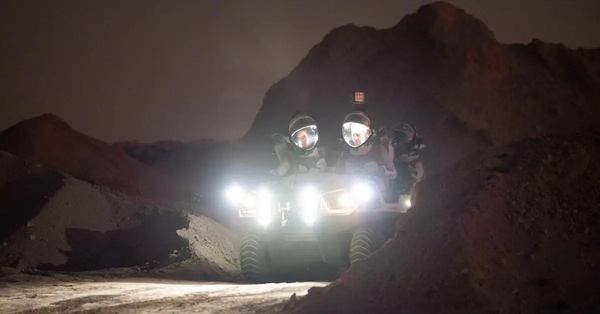 “Stars on Mars” is partly a lightweight summer reality show, but it resembles a science fiction show set on Mars and often looks as good as recent dramas about people living on Mars. (credit: Fox) |
For more on recent Mars-themed TV shows, see: see “Red planet reality,” The Space Review, May 30, 2023; “Red zeitgeist: popular entertainment and the settlement of Mars, part 3,” The Space Review, January 16, 2017; “Love and a Red Planet: popular entertainment and the settlement of Mars (part 1),” The Space Review, November 28, 2016; “Red Planet blues: popular entertainment and the settlement of Mars (part 2),” December 5, 2016; “Mars: Bringer of ennui (part 1),” The Space Review, January 21, 2019 and “Mars: Bringer of ennui (part 2)”, January 28, 2019; “Mars ain’t the kind of place to take your kid: Netflix’s ‘Away,’” The Space Review, October 5, 2020.
Minding The Space Station Gap
Minding the space station gapby Jeff Foust |
| “We’re not going to slow down and slide into the end of the decade,” said NASA’s Montalbano of the ISS. “We’re running full steam to the end of 2030.” |
That logo, present elsewhere at the conference, symbolized the commitment by NASA and its international partners to operate the station through the end of the decade. It was only in March that the last Western partner, Canada, formally made its commitment to participate in the station through 2030.
“Our plan is that we’re going to go to the end of the decade,” said Joel Montalbano, NASA ISS program manager, during a panel that included representatives of Canada, Europe, and Japan. “We’re not going to slow down and slide into the end of the decade. We’re running full steam to the end of 2030.”
Notably absent from the panel was Russia. It was during the same conference a year ago when the new head of Roscosmos, Yuri Borisov, announced—or, at least, seemed to announce—that Russia could depart the ISS partnership after 2024. Such a departure would derail plans to keep the station going until 2030 (see “ISS in the balance”, The Space Review, August 1, 2022).
Borisov and other Russian officials walked back those comments in subsequent weeks, noting that “after 2024” did not mean immediately after 2024. By April, Roscosmos announced it backed continued participation in the ISS to 2028, but not 2030.
Montalbano noted on the panel that Roscosmos worked in four-year increments, so that having previously approved ISS plans to 2024, had extended it to 2028. “As we get closer to 2028,” he said, “we’ll be working together with Roscosmos and all the international partners to see what makes sense.”
He and others at the conference emphasized that the station was hitting its stride from a research standpoint. Crew time, which once limited ISS utilization, has eased with four astronauts on the U.S. segment (which includes the other Western partners), and there were growing research capabilities on the station from government and commercial providers.
“The bottleneck was crew time,” said Frank De Winne, ISS program manager at the European Space Agency, on the panel. “Stepping up to this fourth crew member doubled, or more than doubled, the amount of crew time that we could have on board the space station. That really helped us a lot.”
In many sessions of the conference, researchers discussed the work they were doing on the ISS, from Earth sciences to biomedical, and the potential for future work. But lingering over the conference was uncertainty about just how long the ISS will operate and what will come next.
| “Right now, the ISS is budgeted for perfection. The vast majority of the time, that is exactly what we see,” said Mulholland. |
While station operations are largely going smoothly, such as the installation in spacewalks earlier this summer of new solar arrays to increase power for the ISS as its original arrays age, there are concerns about the sustainability of those operations over the next several years.
“Right now, the ISS is budgeted for perfection. The vast majority of the time, that is exactly what we see,” said John Mulholland, vice president and program manager for ISS at Boeing, the station’s prime contractor. He advocated, though, for what he called “robustness in funding” to ensure the station can handle any hiccups along the way.
That includes concerns about the robustness of access to the station. During the conference last week, a Northrop Grumman Antares rocket successfully launched a Cygnus cargo spacecraft to the station delivering more than 3,750 kilograms of supplies, experiments, and station hardware. It was the 19th mission under a series of contracts that date back not just to before Northrop’s acquisition of Orbital ATK, but the merger of Orbital Sciences with ATK nearly a decade ago.
It was, though, also the last Cygnus launch on the current version of the Antares, called the Antares 230+. Northrop announced a year ago it would retire that version, which uses a first stage built in Ukraine with Russian RD-181 engines, in favor of a domestically produced version in cooperation with Firefly Aerospace. That new Antares 330 rocket, though, won’t be ready for its first flight before the middle of 2025, Northrop officials said at a briefing before the launch.
In the interim, Northrop will launch at least three Cygnus missions on SpaceX’s Falcon 9. At the same time, NASA is relying on SpaceX to transport astronauts on Crew Dragon while Boeing’s CST-100 Starliner suffers more delays: at a briefing Monday, Boeing said the vehicle won’t be ready for its first crewed launch until at least next March. While the Falcon 9 has become a workhorse, making more than 50 launches so far this year, a failure or even an anomaly could disrupt NASA’s ability to get both crew and cargo to the station.
Besides the need for robustness in the ISS supply chain, Mulholland called for additional funding to pay for a new deorbit vehicle NASA plans to develop, at a potential cost of around $1 billion, to ensure a safe reentry of the ISS at the end of its life. He also advocated for upgrades for one of the biggest, and most expensive, instruments on the station, the Alpha Magnetic Spectrometer that studies cosmic rays. He didn't go into details about that upgrade but said the equipment needed for it would require nearly a dedicated cargo flight.
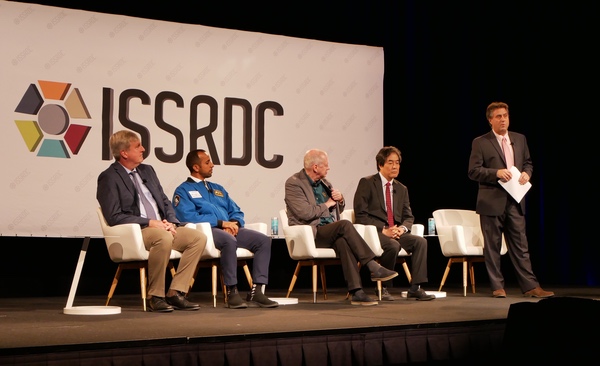 NASA ISS program manager Joel Montalbano (standing) discusses station activities on a panel with representatives from (left to right) Canada, the UAE, ESA and Japan at the ISS Research and Development Conference. (credit: J. Foust) |
Overall, he said that ISS would need steady or even slightly increased funding to cover the costs of those upgrades and new hardware, a challenge in an overall fiscal environment where NASA is facing flat or even decreased budgets. He warned specifically about the cost of the deorbit vehicle: “It must come with new funding or it will significantly impact the ability of ISS sustainment and research utilization.”
By the time the ISS is slated for retirement in 2030, NASA expects one or more commercial space stations to be up and running. But the process by which NASA makes that handover is uncertain.
“That’s a big part of what we’re doing in the next few years, trying to look at that transition from the ISS to these commercial LEO destinations,” Montalbano said. Robyn Gatens, director of the ISS at NASA Headquarters, has been meeting regularly with the partners on the issue, he noted.
“It’s undefined right now,” he said about how that handover will work. “We’re getting inputs from our partners. We want to figure out what’s going to be helpful, what’s not going to be helpful.”
One topic for the international partners has been how they will pay to use those commercial stations. Some, like Europe, have expressed a reticence to directly pay American companies for accessing a station, but an arrangement like the ISS where partners get access based on the services they provide may not be workable.
| “You start to game out the geopolitics. Will the US give up the high ground in space? Highly unlikely,” said Tolusic. |
Those concerns are eased, though, if companies in ISS partner countries have a stake in those commercial space stations. Last week, Voyager Space, once of the companies with NASA awards to work on commercial stations, announced it was forming a joint venture with Airbus Defence and Space to develop its Starlab station. The US-led joint venture, also called Starlab, will develop and operate the station.
Voyager brought in Airbus early this year to provide technical support for Starlab after Voyager parted ways with Lockheed Martin. Matthew Kuta, president of Voyager Space, said that Airbus will also help the venture win business from ESA and its member naitons.
“We have great relationships with ESA, but clearly Airbus much better relationships,” he said. “It allows us to figure out how we can satisfy those customer demands more directly and successfully.”
That approach, though, has its limits. “Imagine if you had to have an international partner from every country. It could get messy,” said Rick Mastracchio, director of strategy and business development at Northrop Grumman Space Systems, on another conference panel. “We really do need NASA and the government’s help on that.”
He and other companies on that panel brought up issues like regulation and liability challenges for commercial space stations, as well as how to move other users and their research capabilities from the ISS to commercial stations. However, a bigger issue is getting the stations developed in time for that handover at the end of the decade.
Commercial space station developers have two major challenges, Mulholland said. One is that there is an “unproven market” for such stations from government and commercial users. The other is the technical obstacles to developing and building such stations, with cost and schedule risk associated with them.
“They will get there, but it will not be easy,” he said of commercial stations. (Boeing is a partner on the Orbital Reef station concept led by Blue Origin and Sierra Space.) Such stations “are the future of the LEO following the ISS, and we need to allow them to follow their natural development cycle.”
| ““We’ll get there, eventually,” Mastracchio said, “but my biggest concern is that we have to get there in a reasonable amount of time.” |
Those challenges and uncertainties also extend to financing such stations, which may cost billions of dollars to build depending on their size and scope. However, some investors speaking on a conference panel played down the concerns, based on the expectation that the government will play a major role in backing and using commercial stations.
“You start to game out the geopolitics. Will the US give up the high ground in space? Highly unlikely,” said Mislav Tolusic, co-managing partner and chief investment officer at Marlinspike Partners. “A huge amount of risk with respect to the market has more or less been taken off the table.”
Whether all that—policy, technology, and funding—can come together to get one or more commercial stations ready to take over from the ISS by the end of the decade is unclear. Montalbano suggested that the ISS could be extended beyond 2030, if needed.
“We’ll be ready to go longer if that’s what the different agencies want us to do, but right now we’re planning to 2030,” he said. “Do we go to 2030 or does it make sense to go longer? If so, we’ll work that together with all the different space agencies and their respective governments.”
“We’ll get there, eventually,” Mastracchio said, “but my biggest concern is that we have to get there in a reasonable amount of time. We cannot have a gap in low Earth orbit.”
There was a subtle, unintentional reminder of the dangers of such a gap in that keychain that conference attendees received. The first thing people saw when they extended the tape was the trinket’s country of manufacture: China.
Jeff Foust (jeff@thespacereview.com) is the editor and publisher of The Space Review, and a senior staff writer with SpaceNews. He also operates the Spacetoday.net web site. Views and opinions expressed in this article are those of the author alone.
Note: we are using a new commenting system, which may require you to create a new account.
